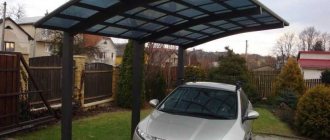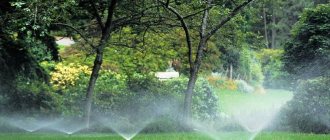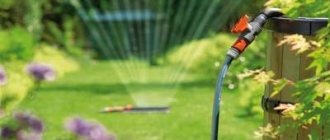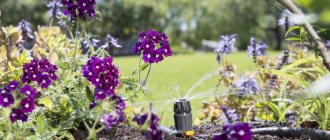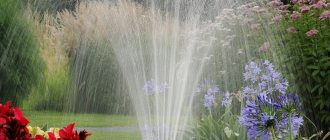Proper watering is as important to maintaining a lush green lawn as sunlight and healthy soil. Too little water and the grass will dry out and die; too much water and it will become oversaturated and die. Watering your lawn seems like a simple enough task, but for most people, knowing when and how to water sparingly can be confusing.
Brief overview of the article
- Understanding the needs of grass
- How often to water the lawn
- Watering the lawn in spring
- Watering by hand
- Automatic watering
- Is the lawn moist enough?
- Irrigation system elements
- water pump
- Water meter
- Pump controller
- Valve box
- Sprinkler shut-off valve
- Backflow prevention device
- Photo of watering the lawn
Understanding the needs of grass
Water conservation is all about growing the right grass. When turf grasses are suited to the local climate, their water needs are synchronized with normal growing conditions in the region. As a result, regionally suitable grasses thrive with less additional water and maintenance than grasses less suited to the area.
Cool-season grasses such as bluegrass or fescue are naturally best grown in cool northern climates, while warm-season grasses such as Bermuda grass or Zoysia grass thrive in warmer southern climates.
Cool-season and warm-season grasses respond differently when water is limited. In general, cool-season grasses lose more water through their pores and are less effective than warm-season grasses at regulating water under stress. For example, some Bluegrass can use 50% more water per day than Bermuda. In some cases the difference can be even greater.
In addition to different water uses, turf grasses vary in drought tolerance. Some grasses avoid drought by holding more water or producing deeper root systems, others avoid drought by remaining dormant, and other species resist the effects of drought by tolerating dehydration well.
Growing regionally appropriate grasses increases the lawn's potential to conserve water and remain healthy and beautiful when water is limited.
Growing water-efficient grass varieties results in lower water consumption, less lawn maintenance and more time to enjoy your lawn.
Description
In order for the lawn to be constantly green, grow well and thickly and, most importantly, be walkable on it, it must be watered correctly and regularly. The intensity of watering depends on many factors, for example, the type of lawn, time of year, air and water temperature. A lawn that does not need to be watered or mowed exists only in the dreams of gardeners, since any plant needs to be looked after. Both seeded and rolled lawns require careful care, regardless of where it grows: in the country or on a plot near the house.
How often to water the lawn
How often should you water your lawn? Watering your grass daily will result in a shallow root system. And small root systems dry out quickly, weakening lawns.
Infrequent, deep watering encourages grassroots to go deep, developing strong systems underground. This allows lawns to be more resilient to weather changes while also becoming more resistant to disease.
How to water the lawn in warm weather? On average, in warm weather, the lawn needs to be watered three times a week. Watering it can be done just once or twice a week to achieve the same goal during the cooler seasons, when there is naturally less evaporation and more chance of precipitation.
When to stop and why?
Watering in central Russia stops completely in the first ten days of October. In the southern regions, the deadline is shifted to the end of October, and in the northern regions they stop watering at the end of September. Plants are preparing for winter, the temperature of the surrounding air and soil decreases, and natural humidity increases.
At this stage, it is necessary to strengthen the root system so that it safely survives the winter and gives rise to the growth of the above-ground part in the spring. Therefore, the lack of moisture inhibits the development of vegetative green mass and allows the root system to make a reserve for the next season.
Watering the lawn in spring
Should you water your lawn in the spring? It all depends on the amount of precipitation. For example, the soil may be dry, so it requires more watering. The hotter and windier it is, the faster it will dry out.
There is no need to water the lawn in winter. During the winter, the grass goes dormant and cool temperatures help prevent the soil from drying out. No matter what time of year it is, the answer is to give your lawn what it needs to thrive.
Types of automatic watering systems and the principle of their operation
Sprinkler irrigation
Sprinkler - the design consists of a pipeline distributed throughout the area at appropriate intervals and special devices - sprinklers, which spray small drops of water through the nozzles over the area. The method is gentle - the impact of the water jet does not damage the plants, the moisture is distributed evenly over the entire surface of the area, small drops of water refresh the air and the heat subsides.
Sprinkler systems, in turn, are divided into retractable and non-retractable systems.
Retractable sprinkler
Underground Sprinkler - The sprinkler is located underground during non-working hours and only moves out to do its job. Such systems are:
- rotary;
- fan-shaped
Rotary ones are divided into adjustable and non-adjustable by design.
By design, all rotor sprinklers consist of a fixed lower part and a rotating rotor head. In unregulated ones, a stream of water falls on the blades and is sprayed around at a given angle.
With adjustable ones, the watering zone can be changed from 40 to 360 degrees. It is convenient to install such structures at the edge of the site or along paths.
The fan retractable sprinkler does not have moving heads. Water comes out of the nozzles. But the spray radius with a diameter of 3 - 4 meters is small, but you can find a sprayer with a radius of up to 6 meters. The area is regulated using limiters.
Fixed sprinkler
The non-retractable sprinkler for irrigation has several designs. They are constantly above ground level, and sometimes rise higher to water tall plants if necessary. These sprinklers are installed on special stands.
Non-retractable ones are divided into:
- pulse;
- pendulum;
- circular;
- sprinkler hoses.
They are called pulse because the water is supplied in separate doses. The nozzle rotates in a circle or in a given sector. The water pressure is constantly changing and due to this, the area is evenly moistened. Their spray radius reaches up to twelve meters. Another advantage is that they are not afraid of contamination.
The design of pendulum sprinklers consists of a tube with nozzles that constantly swings in the range from 0 to 180 degrees. Their superiority lies in the fact that they create a rectangular irrigation spot. The width varies by the swing angle, and the length by changing the number of nozzles in operation. Can be raised on a special tripod.
A circular sprinkler for irrigation, like a rotary one, consists of a fixed platform and a rotating head with nozzles. The range of action is from 3 to 9 meters. Regulation is made by adjusting the water pressure generated by the pump.
A perforated sprinkler hose is a hose with “holes” that is placed in the area where you plan to sprinkle. Water under pressure escapes from the holes (perforations) and produces irrigation. The range is small and ranges from 1 to 3 meters.
Drip irrigation
Drip - the design consists of perforated hoses or watering droppers placed on the irrigation platform connected to a water intake device. Through hoses, small portions of water drip directly onto the roots of the plants. Optimal water consumption and soil moistening in the necessary devices are ensured.
The advantages of such irrigation are:
- No powerful pump is required to create water pressure. A difference of 0.2 atmospheres is enough. It is possible to do without a pump, but with a container raised above the ground 1.5-2.0 meters above the ground. In this case, the water will flow by gravity.
- This method of watering is economical since the water goes directly to the roots.
Watering by hand
Watering your lawn yourself is not the best idea. It seems that this is better for the lawn, but it often turns out that when watering this way, water collects in certain places or even flows away. Often, a lawn that is watered entirely by hand doesn't get as much water as it seems.
The best way to water your grass is to use sprinklers that simulate slow, wet rain. Hand watering is great for very small areas of grass where new grass seed has been planted, or for container plants, but when it comes to the lawn as a whole, it is advisable to use sprinklers for best results.
There are a few things you need to know about using a lawn hose. First, if there is no hose on the hose to control the flow, then the water is essentially just draining onto the grass. This can result in a large volume of water in a small area of your lawn. It turns out that part of the lawn will drown, while the other will remain dry. Additionally, if the yard has a garden or shrubs, the flow of water can damage the petals and stems if the waterer is not careful.
Why water your lawn by hand? It will be more economical this way. Experts believe that manually watering a lawn requires a third of the resources compared to a conventional automatic system. If budget is your main concern, manual watering can reduce utility bills more than automatic sprinklers.
What to consider when watering lawn grass
A well-groomed green lawn is the result of careful and painstaking care. In order for it to resemble an emerald grass carpet, without gaps, weeds and bushes, it must be cut, weeded, fed, reseeded if necessary, and of course watered. Irrigation of lawn grass must be carried out correctly, taking into account all the characteristics of the site. A lawn watering system is the best option to quickly cope with any task.
Consumption
To maintain the lawn in perfect condition, it is necessary to correctly calculate the water consumption. Its amount is determined by soil type, climate and season.
Note! Watering is required when the grass becomes limp and stiff in appearance. It is very important not to miss this moment, otherwise it will have time to turn gray, and the lawn will lose its shine and brightness.
Lawn grass should be watered so that the soil is sufficiently saturated with moisture and becomes wet, but the formation of puddles should not be allowed.
Water consumption can be calculated based on the area of the site. One square meter of grass requires 10-20 liters of water per week. On loose and sandy soil, more abundant watering is required than on clayey soil, since moisture is retained less well on such soil.
Temperature
The optimal water temperature for watering the lawn should be about 5 degrees higher than the air temperature or slightly higher than the soil temperature. This helps improve the absorption capacity of the roots and accelerates the dissolution of mineral salts and trace elements.
Important! In order not to spoil the appearance of the lawn, it is not recommended to use water from wells immediately. For this, it is advisable to have a special tank or container for heating.
The soil temperature for a lawn is usually between 15-25°C, so the water temperature for irrigation should be about the same.
Automatic watering
It goes without saying that an automatic lawn watering system set to water several times a month will use more resources. However, the main real question is: should the lawn go hungry?
Although automatic lawn watering systems require nearly three times more water than manual watering, they create a healthier environment for grass to grow.
However, automatic watering is not without its drawbacks. If the system is not equipped with a sensor that can turn off the sprinklers during rain or after a storm when the soil is still saturated, then it is a waste of money - the owner risks over-watering the lawn, which is harmful to the grass.
Why do you need automatic lawn watering and its features?
Landscape designers claim that an automatic lawn watering system is one of the most important elements of the site that is being improved.
Some consumers consider this a whim, but they are given the following arguments for why automatic watering is needed:
- To rest when you want. Manual watering requires a long time, which will have to be spent watering instead of just resting. Or it may turn out that in the heat, when you need to go away, there will be no opportunity.
- To avoid paying extra to the gardener. Watering is one of the simple but very time-consuming tasks that a gardener must do. Automatic execution of a routine operation will allow the specialist to do other things.
- There will be something to see. Without being distracted by anything in the evening or during the day, you can simply sit on a sun lounger with your household and look at the rainbow that will form in the water mist around the streams of the sprinkler mechanism. It’s not for nothing that there is a proverb that you can watch fire, running water and how others work forever. Harmony with the surrounding nature is created.
- It can be difficult to remember which of the plants needs to be watered abundantly; others do not like large amounts of moisture. Some plants do not like water getting on their buds. There are enough nuances, and the installation of automation solves this problem.
- In order for plants to take root and thrive in your area, they require regular, dosed watering. It is very difficult to organize this manually. Only automatic watering can organize daily, absolutely identical conditions.
Is the lawn moist enough?
There are a few simple tricks that will determine if your lawn is getting enough water. First, does he look healthy? If it looks healthy, then it probably is - which means you should stick to the same volumes of water for irrigation. Another way to determine if your lawn needs to be watered is to plunge a screwdriver into the grass. If it easily drops 15 cm, then the lawn is receiving enough water every week. If not, it may be time to make changes to your watering schedule.
You need to be prepared for weather changes and understand when your lawn needs more feeding and fertilizer. Lawns should be given organic fertilizer and compost in the fall and spring; reduce watering when dry days give way to rainy days.
If mushrooms are growing among your lawn, it is most likely due to overwatering. In such a situation, you should reduce the amount of watering until the mushrooms disappear.
When to start after winter?
The main melting of snow occurs at the end of March. It is necessary to ensure uniform melting by distributing piles of snow and snowdrifts throughout the area. At the same time, movement on damp lawns is minimized. If a drainage system is installed on the lawn, melt water will not stagnate. In this case, drains and drainage wells are cleaned.
How to determine a favorable time?
Watering in spring begins when stable warm weather begins from +15°C. Moistening the soil in cold weather at temperatures below +10°C will not bring any benefit . Usually the first spring watering is combined with fertilizing with mineral fertilizers. Water will dissolve the granules and prevent the first tender greenery from “burning” in the April sun.
Irrigation system elements
When choosing a lawn irrigation system, planning ahead is the most important thing you can do. For those who water their grass with a traditional garden hose and lawn sprinkler from the hardware store, the sprinkler idea may seem deceptively simple.
From the water pump to the lawn sprinkler head, designing a well-functioning lawn watering system is anything but simple. Below is a list of the elements of a lawn irrigation system.
Watering across the width of the zone
Equipment for watering your territory must, first of all, be selected depending on the size of the plot. And only then pay attention to the remaining criteria.
First, let's inspect the area Source heart.mlasolutions.com
Information on choosing equipment according to zone width:
- Small lawn . If the area is small, then there is no need to purchase equipment with special nozzles for a specific spray of moisture. A regular drip sprinkler is suitable, which is a hose with small holes through which water will flow. The liquid in this form is used sparingly, but the lawn will not be watered completely unevenly. The equipment has another name - a fan lawn waterer.
- Middle section . If the plot is of medium size, then it is advisable to purchase more serious waterers that will cope with the task better. The device is selected depending on the configuration of the territory.
- Large plot . For large areas, it is advisable to purchase retractable sprinklers. This equipment is the most powerful and will reach the farthest corners of the territory. But you need to understand that you will need to spend additional money to lay pipes under the territory. The sprinkler will produce water at very high pressure, with a low flow rate and low evaporation.
For a large area - quality sprinklers Source greenhousepeople.co.uk
Pump controller
For lawn irrigation systems, the control system performs two main functions:
- Manages the watering process, ensuring that each zone receives the required amount of water.
- Monitors the system for possible malfunctions and warns when something might happen, and also turns off the system if necessary. The pump controller is connected to the system and system sensors to monitor pressure and flow.
Criterias of choice
Since stores offer a wide range of products, you need to know exactly how to make a purchase for a specific territory.
The range is so wide that there are even funny types of sprinklers Source hitsad.ru
To do this, you need to be guided by certain criteria:
- First of all, it is important to understand what jet pressure is needed to water a certain area. This depends on the distance from the watering can to the object - the further away the plant at the farthest for watering is, the stronger the pressure should be. You can find varieties on which this parameter is adjustable. But in most cases there is only one level.
- Next, you need to look at your site and understand what shape . The choice of type of sprinkler will depend on the shape of the site. The shape can be round, square or rectangular. Average devices are designed specifically for them. On very large areas the number of options increases, but several sprinklers are installed there at once.
- The next point is to decide whether you will need to adjust the tips on your lawn irrigation system. This will change the watering angle. If there is no need to engage in such actions, then there is no point in spending money on expensive models. The average price segment in terms of watering quality will not be inferior to more expensive options.
There are models with customizable adjustment Source remontkvartiri.su
- In some models you can find autonomous watering . To make the right choice, you need to understand whether this function is needed in a particular situation, since if the answer is negative, it is a waste of extra money.
- When the equipment has already been selected, be sure to pay attention to the pressure in the system . If this parameter is bad, then there can be no question of any quality of irrigation. The device will cover, at best, 70% of the selected area.
If you have any difficulties choosing a device, it is advisable to contact a specialist consultant who will tell you what equipment is suitable for a particular type of territory.
Valve box
Valve boxes are not just for valves. Valve boxes are located underground to house sprinkler system components.
The valve box provides the owner with easy access to the sprinkler valve or other components (sensor, wires, etc.).
What are devices for automatic watering of plants and lawns made of?
The automatic lawn watering system is conventionally divided into two types:
- sprinkler;
- drip.
Sprinkler - sprays small or even atomized small jets of water using sprinklers - sprinklers of various types.
Drip - water is supplied using hoses with holes in the required location.
The sprinkler system consists of:
- pump with fine filter;
- controllers that control the entire system with sensors;
- low pressure polyethylene pipes with fittings;
- solenoid valves;
- sprinklers.
The drip irrigation system consists of:
- Storage tank for water;
- Controller with sensors to control the system;
- Electromagnetic valves;
- Low pressure polyethylene pipes;
- Watering drippers;
- Shut-off valves and fittings.
Photo of watering the lawn
Signs of lack of moisture
For healthy growth of lawn grass, it is important to maintain systematic watering. Flooding an area is just as dangerous as not watering it often enough.
The first signs that the grass is not getting enough moisture are as follows:
- the lawn began to be “trampled down” (the grass almost does not rise after it has been crushed);
- the grass begins to curl;
- color changes from rich green to brown;
- bald spots appear on the area;
- the grass begins to wither or turn yellow.
Some varieties of plants remain alive even when the blades of grass have dried out, since their root system goes into a dormant state until the next watering. However, dried grass will not become young and green again. Lawn owners will have to wait for a new one to grow.
Lawn care after planting seeds
The most important component of proper lawn care after planting seeds is timely watering. If you sow seeds and then do not moisten the soil for a week, the grass will die, since the seeds are located shallow in the ground, and due to the wind and sun, the open soil will immediately dry out.
A newly planted lawn should be watered daily for the first 10 days. Within a decade, the grains will germinate, and the root system will be able to absorb moisture, located at a depth of several centimeters.
People who are unable to water recently sown seeds so often can use a trick, namely, cover the area with a film that can retain moisture for a long time. After the seeds have sprouted, the film can be removed, and the air-permeable covering can be left in place as long as it does not interfere with the growth of the grass.
You can also use compost to protect the area from the sun, but mulch can only be used for grass that has grown 7 or 8 cm in height. The area after sowing cannot be covered with mulch, as the seeds will not have enough sunlight and they will die.
The lawn can also be watered through the covering material by simply pouring water from above. One part of the liquid will roll down the material, but the other part will saturate the soil. But, for example, spunbond is unsuitable for irrigation. It protects seedlings from cold or heavy rain, so they cover the lawn with it in late autumn before the onset of winter.
An adult lawn is not as picky about care as a young one, because for the life of the latter, an important criterion is how many times it is watered. After planting, young grass should be moistened at least once a day or two. In extreme heat, the lawn should be watered daily in small portions. As soon as the grass grows up to 7-10 centimeters, you can begin to water the lawn generously.
